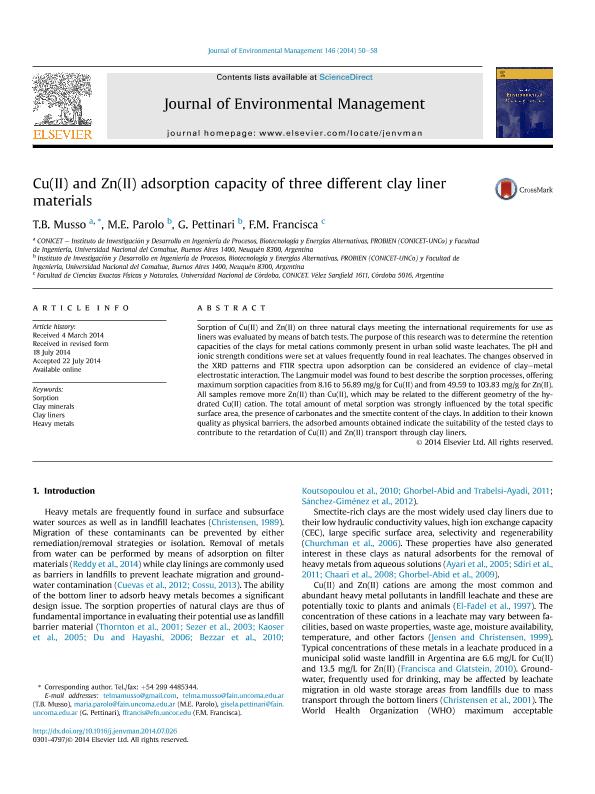Mostrar el registro sencillo del ítem
dc.contributor.author
Musso, Telma Belén

dc.contributor.author
Parolo, M. E.
dc.contributor.author
Pettinari, G.
dc.contributor.author
Francisca, Franco Matias

dc.date.available
2017-01-19T20:37:46Z
dc.date.issued
2014-08
dc.identifier.citation
Musso, Telma Belén; Parolo, M. E.; Pettinari, G.; Francisca, Franco Matias; Cu(II) and Zn(II) adsorption capacity of three different clay liner materials; Elsevier; Journal of Environmental Management; 146; 8-2014; 50-58
dc.identifier.issn
0301-4797
dc.identifier.uri
http://hdl.handle.net/11336/11666
dc.description.abstract
Sorption of Cu(II) and Zn(II) on three natural clays meeting the international requirements for use as liners was evaluated by means of batch tests. The purpose of this research was to determine the retention capacities of the clays for metal cations commonly present in urban solid waste leachates. The pH and ionic strength conditions were set at values frequently found in real leachates. The changes observed in the XRD patterns and FTIR spectra upon adsorption can be considered an evidence of clayemetal electrostatic interaction. The Langmuir model was found to best describe the sorption processes, offering maximum sorption capacities from 8.16 to 56.89 mg/g for Cu(II) and from 49.59 to 103.83 mg/g for Zn(II). All samples remove more Zn(II) than Cu(II), which may be related to the different geometry of the hydrated Cu(II) cation. The total amount of metal sorption was strongly influenced by the total specific surface area, the presence of carbonates and the smectite content of the clays. In addition to their known quality as physical barriers, the adsorbed amounts obtained indicate the suitability of the tested clays to contribute to the retardation of Cu(II) and Zn(II) transport through clay liners.
dc.format
application/pdf
dc.language.iso
eng
dc.publisher
Elsevier

dc.rights
info:eu-repo/semantics/openAccess
dc.rights.uri
https://creativecommons.org/licenses/by-nc-nd/2.5/ar/
dc.subject
Sorption
dc.subject
Clay Minerals
dc.subject
Clay Liners
dc.subject
Heavy Metals
dc.subject.classification
Ciencias Medioambientales

dc.subject.classification
Ciencias de la Tierra y relacionadas con el Medio Ambiente

dc.subject.classification
CIENCIAS NATURALES Y EXACTAS

dc.title
Cu(II) and Zn(II) adsorption capacity of three different clay liner materials
dc.type
info:eu-repo/semantics/article
dc.type
info:ar-repo/semantics/artículo
dc.type
info:eu-repo/semantics/publishedVersion
dc.date.updated
2017-01-17T19:21:55Z
dc.journal.volume
146
dc.journal.pagination
50-58
dc.journal.pais
Estados Unidos

dc.journal.ciudad
Nueva York
dc.description.fil
Fil: Musso, Telma Belén. Consejo Nacional de Investigaciones Científicas y Técnicas. Centro Científico Tecnológico Patagonia Norte. Instituto de Investigación y Desarrollo En Ingeniería de Procesos, Biotecnología y Energías Alternativas; Argentina. Universidad Nacional del Comahue. Facultad de Ingeniería; Argentina
dc.description.fil
Fil: Parolo, M. E.. Consejo Nacional de Investigaciones Científicas y Técnicas. Centro Científico Tecnológico Patagonia Norte. Instituto de Investigación y Desarrollo En Ingeniería de Procesos, Biotecnología y Energías Alternativas; Argentina
dc.description.fil
Fil: Pettinari, G.. Consejo Nacional de Investigaciones Científicas y Técnicas. Centro Científico Tecnológico Patagonia Norte. Instituto de Investigación y Desarrollo En Ingeniería de Procesos, Biotecnología y Energías Alternativas; Argentina
dc.description.fil
Fil: Francisca, Franco Matias. Universidad Nacional de Cordoba. Facultad de Cs.exactas Fisicas y Naturales. Departamento de Construcciones Civiles; Argentina. Consejo Nacional de Investigaciones Científicas y Técnicas; Argentina
dc.journal.title
Journal of Environmental Management

dc.relation.alternativeid
info:eu-repo/semantics/altIdentifier/url/http://www.sciencedirect.com/science/article/pii/S0301479714003752
dc.relation.alternativeid
info:eu-repo/semantics/altIdentifier/doi/http://dx.doi.org/10.1016/j.jenvman.2014.07.026
Archivos asociados
